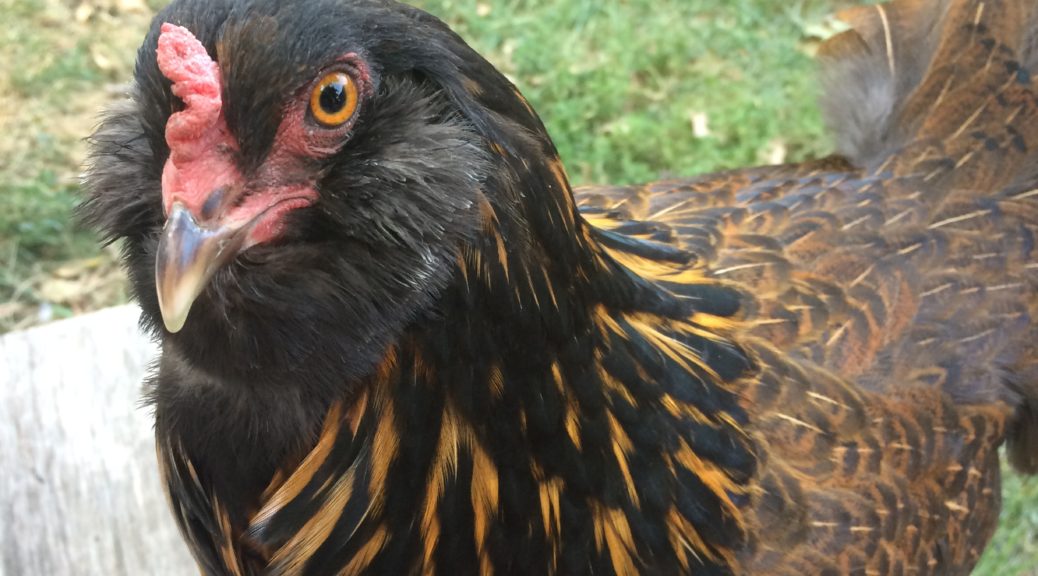
Chicken Breeds: Which One Is Right For You?
When you get serious about wanting chickens, one of the first questions you ask yourself is, “Which breed should I get?” There are hundreds of different chicken breeds, and each one has its pros and cons. As I was researching the different options, I actually made myself a handy breed reference chart! (No I’m not overly Type A, why do you ask?) I decided I’d share the chart with you here, and go over some of the most common chicken breeds. Then you can decide which ones may or may not be right for you!
What are you looking for?
The most obvious point to start with is… why do you want chickens? For most people, the number one reason to keep chickens is to get fresh eggs. This is no doubt one of the best advantages to having a backyard flock! If that’s the case for you, egg production will be your most important factor.
If you’re like me and mostly want to keep chickens as pets, with eggs being a lovely bonus, then you’re going to want a very friendly breed. This is especially important if you have kids! If you live in a very hot, or alternately very cold place, you’ll prefer birds who do well in that climate. And of course, looks are important, too! I’ve taken most of these traits into consideration on my Breed Chart, below.
Alternately, if you’re raising chickens to eat, you will want a meat bird and not an egg layer. Because meat birds are not something I have a lot of experience with, I’ve chosen to focus on egg laying breeds in this post.
What do you mean by…?
As you’re researching chicken breeds, you may come across some terms you haven’t heard before. I want to define them before we go on! Here are some common words we use in the chicken world, that you may not be familiar with:
Bantam – A bantam breed is a miniature version of a standard breed. It’s not a breed in and of itself. Bantam chickens are generally 1/4 – 1/2 the size of their standard counterpart. Of course that means their eggs will be tiny, too! If you’re in it for the eggs, bantams are probably not a good choice. They also have a harder time keeping warm because of their size. But there’s no arguing that they’re adorable!
Broody – This is the term we use for a chicken who suddenly decides she’d like to be a mama. Broody hens may become aggressive when you try to collect eggs, and will not want to leave the nest. They may even begin hiding eggs in the coop or another area of your property! Some chicken breeds are a lot more likely to “go broody” than others. It doesn’t matter if you have a rooster or not, sometimes it just happens, and you will need to break them of it if you don’t want chicks.
Sex Link – Sex link chickens are bred to have gender-specific physical traits, like a particular coloring. This makes sorting them easy from day one, which means you’re a lot less likely to get an accidental rooster in the bunch!
The Breed Chart
I chose to include breeds that are generally easy to find at farm supply stores, and are not typically aggressive, flighty, or noisy. If they’re not on the chart, they’re probably not a great bird to keep as a pet. Some of the breeds, like Silkies, will likely have to be bought from a hatchery or breeder. And now, without further ado, the breed chart!
Some Extra Notes on Chicken Breeds
Ameraucana and Araucana – These are very similar breeds, with slight differences in physical traits. The most noticeable difference is that Araucanas have no tail. They are both fairly rare and lay pretty blue eggs. They tend to be very hardy and sweet.
Easter Egger – This is not an actual recognized breed, but rather a mix of either an Ameraucana or Araucana with another breed. Easter Eggers usually lay greenish eggs, but sometimes lay blue, pink, yellow, tan… well, Easter eggs! Often stores will label Easter Eggers as Ameraucana or Araucana by mistake. To get a purebred, you will likely need to order from a hatchery.
Jersey Giants – These are called giants for a reason! They’re very friendly birds, but HUGE. You will want to keep that in mind when it comes to space and food requirements!
Polish – These are the chickens with the crazy bouffant hair do’s! They can act a little peculiar sometimes, often due to their eyesight being blocked by their head feathers. They are small, and don’t lay eggs often – but they’re a favorite as pets!
Rhode Island Red/Production Red – Sometimes when a store lists chicks as Rhode Island Reds, they are actually Production Reds. Production Reds are a mix of Rhode Island Red and another breed, often a White Leghorn. This results in lighter coloring, and usually, higher egg production. They’re said to have a sweeter disposition, too. But if you want a purebred, you will want to check the source!
Silkie – Silkie chickens actually have very soft feathers that are more like fur! Their skin is bluish-black, and they can be some of the sweetest chickens you will meet. They make fantastic little mothers, but that also means they’re very likely to go broody on you.
Wyandotte – Wyandottes are probably my favorite breed based on looks alone. They have a beautiful lacy pattern. Black and white Wyandottes are called Silver Laced, and golden brown and black Wyandottes are called Gold Laced. There are also more rare versions of the breed, including the gorgeous Pencil Laced Wyandotte.
What you DON’T want
If you’re going to be keeping chickens for any reason other than to cull (butcher) them for meat, do NOT get any chicks labeled “pan fry”! Stores don’t even bother trying to sex these chicks, because they’re supposed to be butchered before adulthood. If you see the phrase “straight run”, it means the same thing – they haven’t been sorted. Of course there is no guarantee that you’ll only get hens even if they have been sorted. (Ask me how I know!) Pan fry birds can have severe physical problems if they’re not culled before reaching maturity. Their bodies can end up being too heavy for their legs, resulting in broken legs, pain, illness, and other issues. These are NOT birds you want to keep as pets, as it would be cruel to do so.
What I Wanted For My Flock
When I started looking at which breeds I wanted for myself, my hopes were typical for a backyard flock. I wanted birds that, above all, were friendly. As I said before, my girls are pets more than livestock, and I wanted them to get along well with me and my children. Of course I wanted them to be good layers too, with at least 3 eggs per week. I wanted interesting and intricate patterns, and I LOVE the black and white combinations! I also wanted them to be both cold hardy and heat tolerant, as our temperatures here are very high in summer and very low in winter.
That seemed like an awfully big wish list, which is actually why I created my chart in the first place! I needed a good visual to help me see quickly and easily which breeds would best fit my desires. Heat tolerance was the hardest trait to find, so I tried to focus on my other needs. More than anything though, my breed options would be limited by what our local store carried!
What I Ended Up Getting
I had narrowed my wish list down to Barred Rock, Wyandotte, Easter Egger (because I definitely wanted some pretty colored eggs!), Buff Orpington, and Rhode Island Red. I didn’t know yet what the store in my town would carry, but I hoped to at least be able to find a couple of the breeds I wanted. Imagine my surprise when I walked in one day and found that they had four of my five desired breeds! This was in February, which was a full six weeks before I had planned to bring home chicks. I didn’t want to miss my chance though, so I went ahead and bought one of each. I brought home a Barred Rock, Wyandotte, Easter Egger, and a Rhode Island Red.
The Rhode Island Red actually ended up being a surprise in two ways. First, I finally figured out it was a Production Red, not a Rhode Island Red. And second, she turned out to be a he! He stayed with us until he was about 15 weeks old, and was sweet as can be. Due to noise concerns though, he had to go live on a farm, where he’s very happy. Here are my three remaining girls now:
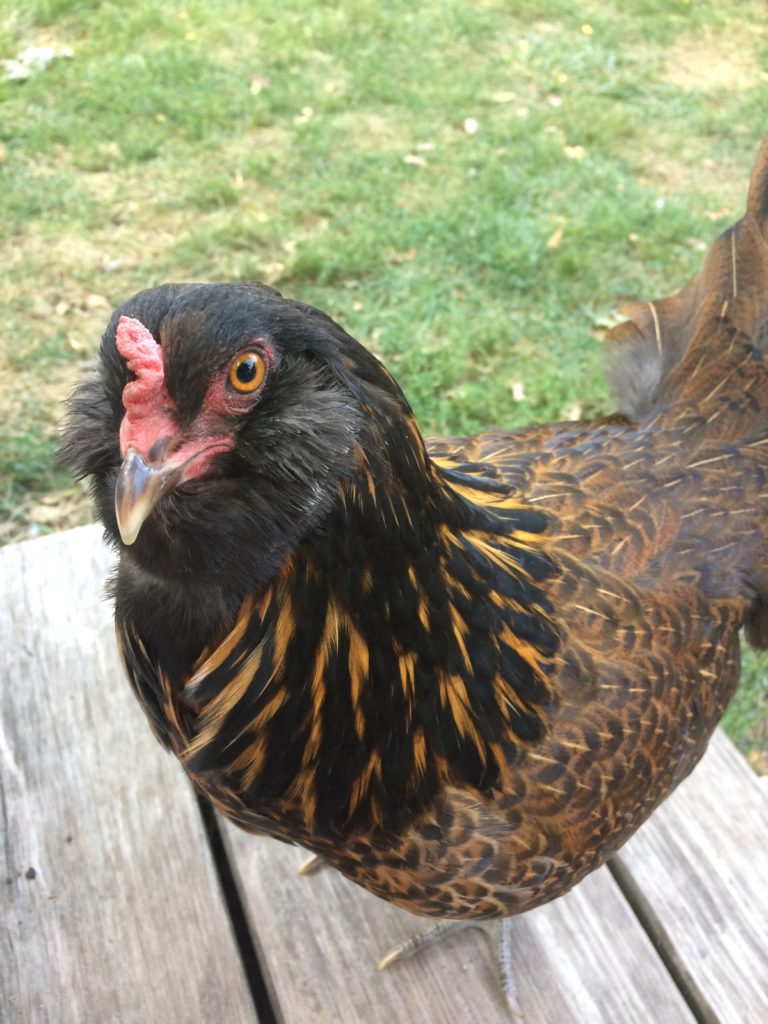
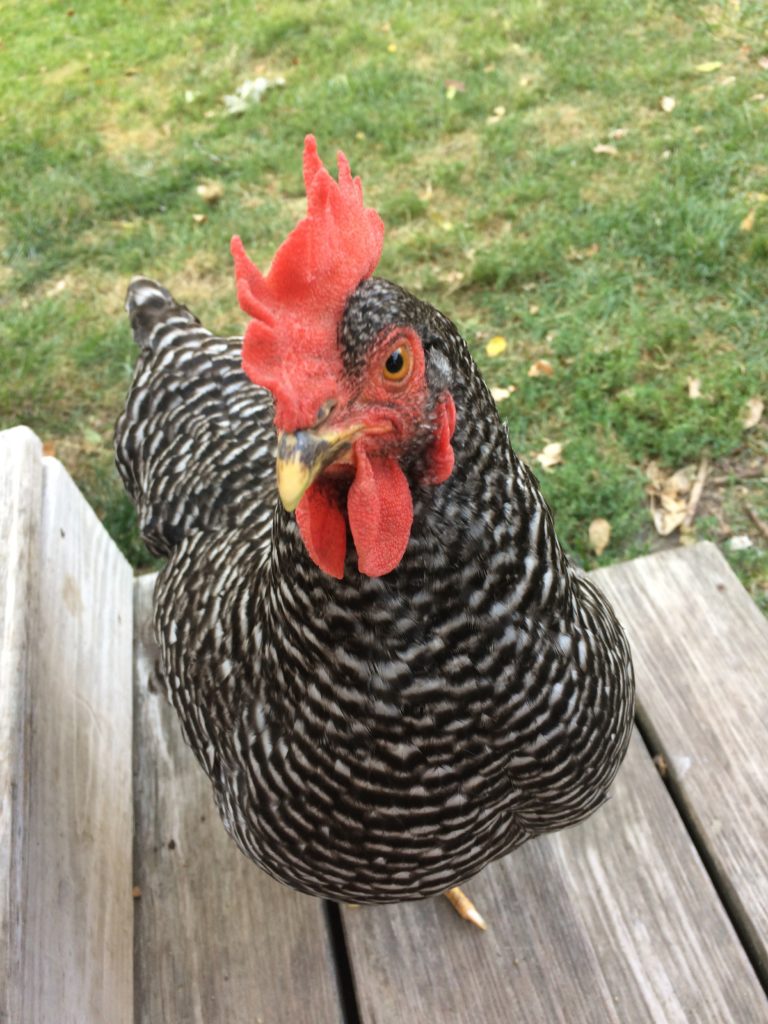
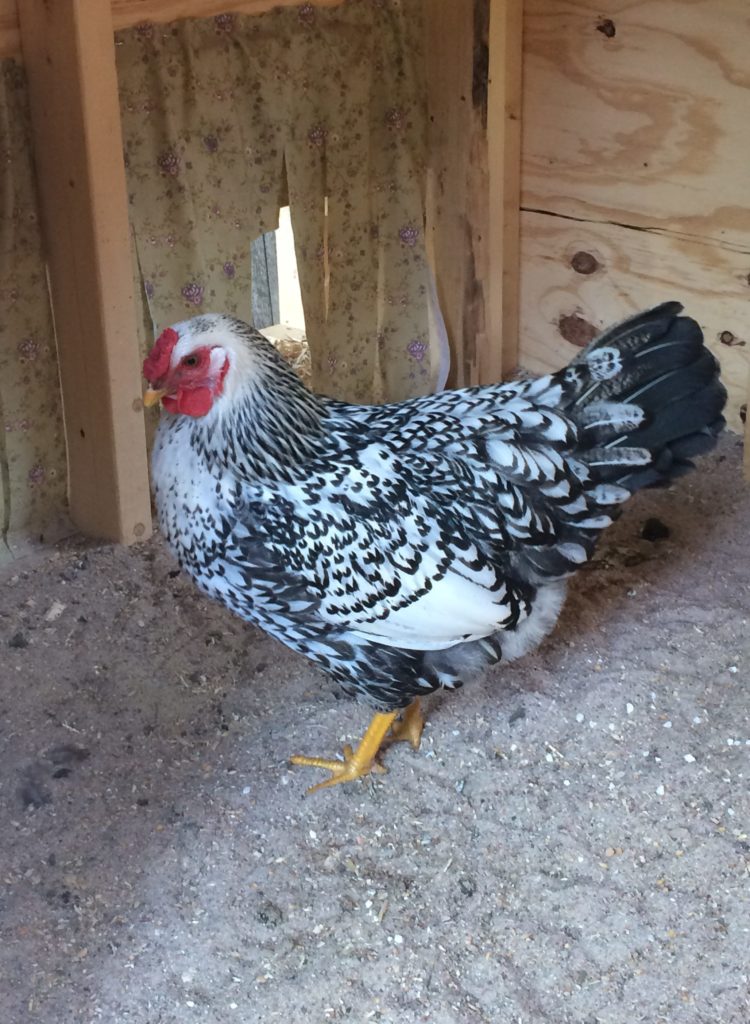
So Were They True To The Chart?
Overall, my chickens fit their breed descriptions well and I’m very happy with my choices. My Barred Rock and Easter Egger are super friendly. My Wyandotte is very skittish, even though I raised her almost from birth. Though the Barred Rock and Wyandotte are large birds, they both lay small eggs – smaller than the ones my tiny Easter Egger lays, actually! I’m hoping the eggs will get bigger as the girls get older. They’re all excellent layers, each giving me 5-7 eggs per week. They haven’t been cold-tested yet, but they all did fairly well in the summer heat. And true to her breed, my Barred Rock doesn’t love being confined. She always lets me know if I forget to let them out to free-range after lunch!
What Chicken Breeds Will You Choose?
Some people prefer to have a flock that’s all one breed, and others want some of everything! Fortunately, chicks are cheap and easy to sample. 😉 When it comes down to it, you’re the only one who can choose the right chicken breeds for you. I do hope that this chart helps you in your decision making. I’d love to hear what you ended up with, and why!
~~~
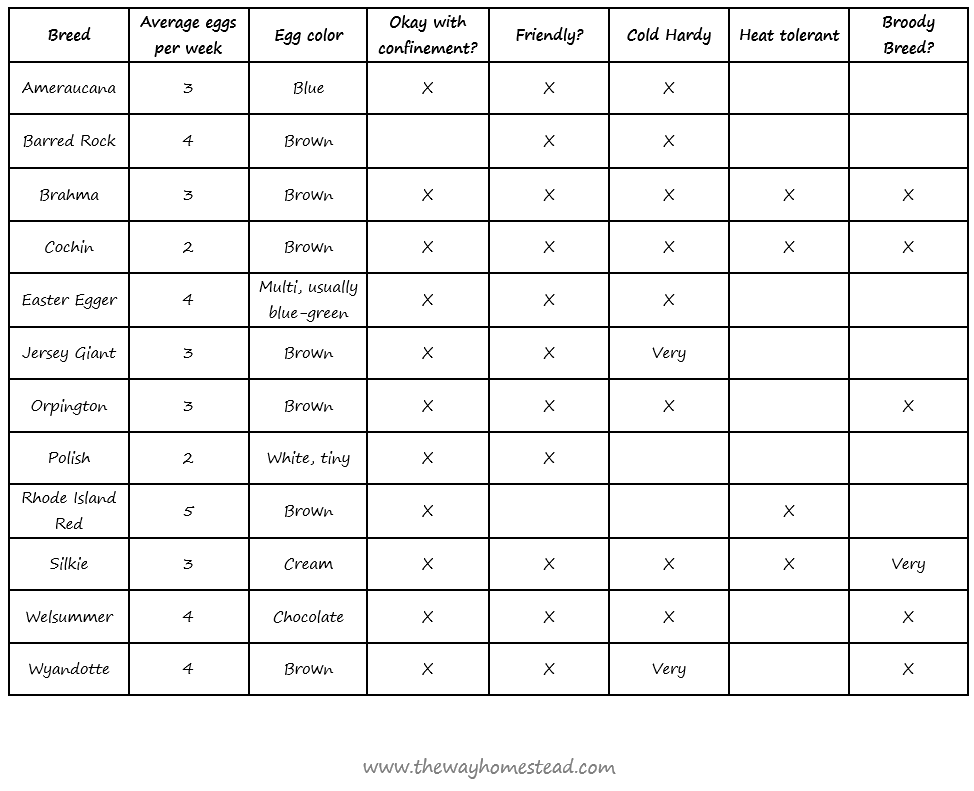
5 thoughts on “Chicken Breeds: Which One Is Right For You?”
We have 3 Rhode Island reds, 7 buff Orpingtons, and 3 Ameraucana( not Easter eggers). We’ve had New Hampshire’s and barred rocks, too. The barred were beautiful but huge. They also killed every dove that got into their pen. They were re-homed. The New Hampshire’s were wonderful. I prefer them to the reds. They also lay through our winters with just our back porch light. Very friendly are the New Hampshire’s. We get hot summers, but provide shade for all our birds. They get loads of insects in their diet and loads of attention. When the garden gets a bit bigger, we plan to let the orpingtons and Ameraucana run around to forage, like the reds do. They do a lot of our insect control for us, along with the wild scrub jays and wasps. Only the reds are old enough to lay, about an egg a day. Can’t wait for pretty blue eggs in September or October.
I’m interested in your black and white chicken breeds
Hi! My two black and white breeds are Barred Rock (mostly black with white spots) and Silver Laced Wyandotte (that look more like white with a lacey black pattern). They’re both great laying breeds, too. In my experience, Barred Rocks are extremely friendly and tame, and Wyandottes are more skittish. Black and white chickens are my favorite!
Do you sell fertile eggs?
Hi Michelle! We don’t keep a rooster with our small flock, so no, I don’t have or sell fertile eggs.